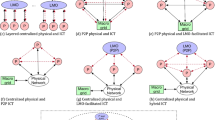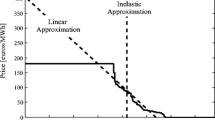Abstract
We study a bi-level energy market and a transmission system that sends the energy supply generated in the upstream market to consumers in the downstream market. The players including manufacturers and wholesalers in this market can exercise the market power to affect the productive efficiency of the energy supply. To analyze the impact of market power, we formulate the mixed complementarity problems to identify the Nash equilibrium and use a directional distance function to estimate the efficiency by the directional vector toward the Nash equilibrium. We investigate two cases of market power in the energy market: wholesalers as leaders, or bilateral bargaining power between manufacturers and wholesalers. The numerical study of a power generation market is conducted and the results show that the Nash equilibriums in the two cases provide the insights to drive the productivity and support environmental policies. Particularly, a sensitivity analysis shows that price volatility in the upstream transmission market significantly influences the equilibrium solution.









Similar content being viewed by others
Data Availability
The data that support the findings of this study are available from China Electric Power Yearbook (2014).
Notes
Note that a bi-level market defined in the current study does not directly imply a leader–follower game, and it describes an upstream–downstream relation in an energy transmission market.
This study focuses on model generalization and productivity, and does not consider the wholesalers’ geographical constraints related to energy transmission.
Some assumptions in this numerical study is not be totally valid as real settings in China, such as imperfectly competitive electricity market or one aggregated demand formulated by inverse demand function. However, these assumptions can also be regarded as a scenario analysis due to deregulation in the power market [11, 10, 17]. This assumption can provide some interesting factors and insights.
The numerical study was performed on a personal computer (PC) with an Intel Core i7-4770 CPU @ 3.40 GHz and 8 GB RAM. The optimization problems were solved in GAMS 23.3 using the PATH solver [8]. The typical CPU computation time ranged from 5 to 20 s.
For one specific power plant, we average the contract price by all TSOs, and for one specific TSO, we average the contract price by all power plants.
Note that for efficiency estimation of TSOs, Eq. (2) is corrected by the production possibility set \(T\) as the typical variable-returns-to-scale (VRS) DEA model without undesirable outputs.
We calculate the normalized efficiency score by \(1 - \theta^{*} /\theta^{\max }\), where \(\theta^{*}\) is the DDF and \(\theta^{\max }\) is the largest DDF used for normalization. A nonnegative DDF \(\theta^{*} = 0\) means a firm is efficient; otherwise, it is inefficient. After normalization, the efficiency scores are comparable among four models.
In Case 1 and Case 2, it is possible to have no DMU with efficiency score equal to 1; all DDFs estimated by Nash direction are larger than 0 (e.g., although Plant 10 is located on the efficient frontier according to Chung and Färe, it can still move toward the Nash equilibrium located on the efficient frontier for improvement.
We only discuss a situation where the parameters have the same proportional change for each contract price setting between a plant and a TSO, to understand the impact on the Nash equilibrium solution.
Abbreviations
- \(i\) :
-
Index of input, \(i \in I\)
- \(q\) :
-
Index of output, \(q \in Q\)
- \(k\) :
-
Index of manufacturer, \(k \in K\)
- \(r\) :
-
Index for one specific manufacturer and an alias of index \(k\), \(r \in K\)
- \(h\) :
-
Index of wholesaler, \(h \in H\)
- \(n\) :
-
Index for one specific wholesaler and an alias of index \(h\), \(n \in H\)
- \(T\) :
-
Production possibility set
- \(\lambda_{k}\) :
-
The intensity weights of the convex combination between players
- \(\mu_{k}\) :
-
The variable for the weak disposability property of Podinovski’s convex technology
- \(\theta\) :
-
The decision variable representing the estimate of efficiency
- \(p_{kh}^{C}\) :
-
Contract price negotiated between manufacturer and wholesaler in the upstream market
- \(p_{{}}^{S}\) :
-
Wholesale price as an inverse demand function with a single aggregated consumer
- \(I_{kh}^{T}\) :
-
The purchased quantity transmitted from manufacturer \(k\) into wholesaler \(h\)
- \(\lambda_{rk}^{C}\) :
-
The intensity weights of the convex combination between manufacturers
- \(\mu_{rk}^{C}\) :
-
The weak disposability of Podinovski’s convex technology between manufacturers
- \(O_{rh}^{C}\) :
-
The amount of energy supply transmitted to wholesaler \(h\) from manufacturer \(r\)
- \(O_{h}^{T}\) :
-
The amount of energy supply transmitted from wholesaler \(h\) to customers
- \(\lambda_{nh}^{T}\) :
-
The intensity weights of the convex combination between wholesalers
- \(\tau_{ri}^{C} ,\varphi_{r}^{C} ,\gamma_{rq}^{C} ,\delta_{r}^{C} ,\varepsilon_{r}^{C}\) :
- \(\tau_{nl}^{T} ,\varphi_{n}^{T} ,\gamma_{n}^{T} ,\delta_{n}^{T} ,\varepsilon_{nl}^{T} ,\theta_{n}^{T} ,\rho^{T} ,\omega_{n}^{T} ,\sigma_{kn}^{T}\) :
- \(X_{ki}^{{}}\) :
-
The \(i\)th input of firm \(k\)
- \(Y_{k}^{{}}\) :
-
The single desirable output of firm \(k\)
- \(B_{kq}^{{}}\) :
-
The \(q\)th undesirable output of firm \(k\)
- \({\varvec{g}}\) :
-
The direction vector \({\varvec{g}} = \left( {{\varvec{g}}_{x} ,g_{y} ,{\varvec{g}}_{b} } \right)\) used in directional distance function
- \(X_{ki}^{C}\) :
-
The \(i\)th input of manufacturer \(k\)
- \(Y_{k}^{C}\) :
-
The single desirable output of manufacturer \(k\)
- \(B_{kq}^{C}\) :
-
The \(q\)th undesirable output level of manufacturer \(k\)
- \(\alpha_{kh}^{C}\) :
-
Positive intercept of contract price equation \(p_{kh}^{C} = \alpha_{kh}^{C} - \beta_{kh}^{C} I_{kh}^{T}\)
- \(\beta_{kh}^{C}\) :
-
Discount parameter of contract price equation \(p_{kh}^{C} = \alpha_{kh}^{C} - \beta_{kh}^{C} I_{kh}^{T}\)
- \(w_{i}\) :
-
The price of input \(i\)
- \(\alpha^{S}\) :
-
Positive intercept of inverse demand function \(p^{S} = \alpha^{S} - \beta^{S} \hat{O}^{T}\)
- \(\beta^{S}\) :
-
Price-sensitive coefficient of the energy supply in the inverse demand function
- \(\overline{O}^{T}\) :
-
The least and fixed amounts generated by the wholesalers without market power
- \(X_{hl}^{T}\) :
-
The \(l\)th input level of wholesaler \(h\)
- \(Y_{h}^{T}\) :
-
The single output (energy supply) level of wholesaler \(h\)
- \(T_{n}\) :
-
The upper bound of the transmission line’s capacity from wholesaler \(n\) to customers
- \(D\) :
-
The customer demand
References
CEPP: China electric power yearbook. China Electric Power Press, Beijing (2014). (in Chinese)
Chen, H.-K., Lin, Y.-H., Lee, C.-Y.: Convex nonparametric least squares and stochastic semi-nonparametric frontier to estimate the shadow prices of PM25 and NOx for Taiwan’s transportation modes. Int. J. Sustain. Trans. 15(9), 659–577 (2020)
Chung, Y.H., Färe, R., Grosskopf, S.: Productivity and undesirable outputs: a directional distance function approach. J. Environ. Manag. 51(3), 229–240 (1997)
Daskalakis, C., Goldberg, P.W., Papadimitriou, C.H.: The complexity of computing a Nash equilibrium. SIAM J. Comput. 39(1), 195–259 (2009)
EEA: Annual report 2013 and environmental statement 2014. European Environment Agency, Copenhagen (2014)
Fampa, M., Barroso, L.A., Candal, D., Simonetti, L.: Bilevel optimization applied to strategic pricing in competitive electricity markets. Comput. Optim. Appl. 39, 121–142 (2008)
Färe, R., Grosskopf, S., Weber, W.L.: Shadow prices and pollution costs in U.S. agriculture. Ecol. Econ. 56(1), 89–103 (2006)
Ferris, M.C., Munson, T.S.: Interfaces to PATH 3.0: design, implementation and usage. Comput. Optim. Appl. 12(1–3), 207–227 (1999)
Fried, H.O., Lovell, C.A.K., Schmidt, S.S.: The measurement of productive efficiency and productivity growth. Oxford University Press, New York (2008)
Gabriel, S.A., Conejo, A.J., Fuller, J.D., Hobbs, B.F., Ruiz, C.: Complementarity modeling in energy markets. Springer, New York (2013)
Hobbs, B.F., Pang, J.S.: Nash-Cournot equilibria in electric power markets with piecewise linear demand functions and joint constraints. Oper. Res. 55(1), 113–127 (2007)
IPCC: Climate change 2013: the physical science basis: working group I contribution to the fifth assessment report of the intergovernmental panel on climate change. Cambridge University Press, Cambridge (2014)
Kuosmanen, T., Podinovski, V.: Weak disposability in nonparametric production analysis: reply to Färe and Grosskopf. Am. J. Agric. Econ. 91(2), 539–545 (2009)
Lee, C.-Y.: Distinguishing operational performance in power production: a new measure of effectiveness by DEA. IEEE Trans. Power Syst. 30(6), 3160–3167 (2015)
Lee, C.-Y.: Nash-profit efficiency: a measure of changes in market structures. Eur. J. Oper. Res. 255(2), 659–663 (2016)
Lee, C.-Y.: Mixed-strategy Nash equilibrium in data envelopment analysis. Eur. J. Oper. Res. 266(3), 1013–1024 (2018)
Lee, C.-Y.: Decentralized allocation of emission permits by Nash data envelopment analysis in the coal-fired power market. J. Environ. Manag. 241, 353–362 (2019)
Lee, C.-Y., Johnson, A.L.: Measuring efficiency in imperfectly competitive markets: an example of rational inefficiency. J. Optim. Theory Appl. 164(2), 702–722 (2015)
Lee, C.-Y., Charles, V.: A robust capacity expansion integrating the perspectives of marginal productivity and capacity regret. Eur. J. Oper. Res. 296(2), 557–569 (2022)
Mehrabani, R.P., Seifi, A.: The impact of customers’ channel preference on pricing decisions in a dual channel supply chain with a dominant retailer. J. Ind. Prod. Eng. 38(8), 599–617 (2021)
Myerson, R.B.: Nash equilibrium and the history of economic theory. J. Econ. Lit. 37(3), 1067–1082 (1999)
Nash, J.: Non-cooperative games. Ann. Math. 32, 286–295 (1951)
NEA: 2013–2014 Annual national power enterprise price supervision report. China National Energy Administration, Beijing (2015). (in Chinese)
Ruiz, C., Conejo, A.J., Fuller, J.D., Gabriel, S.A., Hobbs, B.F.: A tutorial review of complementarity models for decision-making in energy markets. EURO J. Decis. Process. 2, 91–120 (2014)
Shephard, R.W.: Indirect Production Functions. Anton Hain Verlag, Meisenheim Am Glan (1974)
Tseng, C.-Y., Lee, C.-Y., Wang, Q., Wu, C.: Data envelopment analysis and stochastic equilibrium analysis for market power investigation in a bi-level Market. Transp. Res. Part E: Logist. Transp. Rev. 161, 102705 (2022)
Wang, K., Xian, Y., Lee, C.-Y., Wei, Y.-M., Huang, Z.: On selecting directions for directional distance functions in a non-parametric framework: a review. Ann. Oper. Res. 278(1–2), 43–76 (2019)
Yang, F.: How the coal consumption affects the climate in China. Available at: http://www.nrdc.cn/coalcap/ (2014). June 14, 2016. (in Chinese)
Yang, D., Zhang, L., Luo, M., Li, F.: Does shipping market affect international iron ore trade: An equilibrium analysis. Transp. Res. Part E Logist. Transp. Rev. 144, 102107 (2020)
Zhuang, J., Gabriel, S.A.: A complementarity model for solving stochastic natural gas market equilibria. Energy Econ. 30(1), 113–147 (2008)
Zugno, M., Morales, J.M., Pinson, P., Madsen, H.: A bilevel model for electricity retailers’ participation in a demand response market environment. Energy Econ. 36, 182–197 (2013)
Acknowledgements
This study was funded by the Ministry of Science and Technology of Taiwan (MOST108-2221-E-006 -223-MY3).
Author information
Authors and Affiliations
Corresponding author
Additional information
Communicated by Arvind Raghunathan.
Publisher's Note
Springer Nature remains neutral with regard to jurisdictional claims in published maps and institutional affiliations.
Rights and permissions
Springer Nature or its licensor (e.g. a society or other partner) holds exclusive rights to this article under a publishing agreement with the author(s) or other rightsholder(s); author self-archiving of the accepted manuscript version of this article is solely governed by the terms of such publishing agreement and applicable law.
About this article
Cite this article
Lee, CY., Tseng, CY. Market Power and Efficiency Analysis in Bi-level Energy Transmission Market. J Optim Theory Appl 196, 544–569 (2023). https://doi.org/10.1007/s10957-022-02147-3
Received:
Accepted:
Published:
Issue Date:
DOI: https://doi.org/10.1007/s10957-022-02147-3




